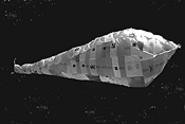Although Chicago artist Patrick Miceli collects and counts his objects with precision, his theme is that it is impossible to force objects to do the artist's bidding. Because he chooses to work with common items like soft drink paper cups, he believes that viewers will be able to add their own associations to the material and thus escape the tyranny of the artist's view of his own work. This is certainly an idea worth exploring. The film theorist Leo Braudy was surely right when he noted that, in film, "no matter how much control the director and set decorator have over every object in the scene, we may still feel that the objects are there by chance and may at any moment vanish or extend themselves into the life beyond the frame."
The same could be said of this art. In one corner of the gallery, Miceli has stacked hundreds of paper cups from fast food restaurants. Emblazoned with Coca-Cola and Pepsi emblems as well as ads for Pokémon, the cups spill out of a gallery trap door. The work seems to ask: Is media manipulation so pervasive that it's useless trying to quell its impact? Unfortunately, this work is so visually uninteresting that one forgets what's in the gallery and instead remembers the last trip to McDonald's -- at least there, the cups were filled with a soft drink. Braudy hinted that, because objects within the screen tend to spill over into their life outside the film, the artist can use this tension productively, but Miceli seems unable to take that step.
After all, it's hardly an intellectual thunderbolt to suggest that, just as garbage spills through a trap door, the mass media spill over into our lives, whether we want them to or not. That's the metaphor here, and it's hammered home so insistently that it closes interpretive options and discourages thought. Warhol did neither when he made a Brillo box that looked like the real thing and placed it in an art gallery context. The Brillo box in real life and the art gallery replica were each members of a different world -- one came from Warhol's art studio, while the "original" came from the makers of Brillo -- yet the artist wondered, with us, if they were distinguishable. Miceli's work, by contrast, is a one-liner about the power of the media. No ambiguity here.
No ambiguity in the art of Jennifer Jaia Chen either. She repeats a gesture in order to make a point, but succeeds only in reducing the power of some pretty important ideas. In a statement, the artist notes that "breath, even though we cannot touch it, is what moves through our bodies and makes us alive." So far, so good. It's the next step that is the problem. Chen fills up dozens of balloons with her own breath, and we see the product of her labor behind a glass enclosure. "I give the balloon my breath, my energy, my life. This particular balloon then becomes my balloon," she says.
The work seems to have a strong Eastern underpinning, insofar as a major component of Eastern religion is the notion that the essential you is part of the ultimate spiritual reality, and by discovering what is essential in oneself, one can connect with the forces that order the universe. Chen expresses the idea by suggesting that, by filling the balloons with her own breath, she is becoming part of the room, and that, in turn, the room is filled with her. This work is certainly conceptually focused, but seeing lots of balloons in an enclosed space is a drab experience. Does this artist feel a sense of thrill and wonderment upon realizing that all can be in one and that one can be in all, or is this something that is simply accepted as part of her existence and thus not to be fussed over? The work suggests the latter, even though the artist's statement suggests the former. It would have been much better if this situation were reversed.
Another work by Chen suggests that all is not philosophy and religion in this exhibit. Humor is a component, too. One could easily do without it, though, because it's frequently not funny. For example, Chen's "Cud-Gum Chewing Exercises" consists of a heap of partially chewed gumballs stuck into a corner of the gallery. The whole area has a sugary smell. What the artist intends with this multicolored goo is anyone's guess. Also perplexing are Chen's drawings, which consist of oil stains and food stains. They look as though vegetable oil on paper has been given liberal doses of paprika or Tabasco sauce.
Why?
There is one work in the exhibit that manages to be both thought-provoking and amusing. It's called "Vacuum Ovipositor 1," and it's by Athens, Ohio, artist Daniel Loewenstein. The idea harks back to surrealistic experiments by artists, like René Magritte, who demonstrated their interest in the unconscious by painting common objects doing things that they normally don't do. Magritte's tuba caught on fire, and his candle was placed in a nest where it laid eggs. Loewenstein's vacuum cleaner does not clean floors. The cleaner doesn't have a dirt bag attached to it. Instead, the artist has attached his own version of a dirt bag -- a massive balloon made out of shopping bags melted together (one proclaims, "Recycle for a Better World"). The point here is that all this recycling is useless. All this effort has gone into making an item that has no practical function. The vacuum cleaner, too, is exempted by the artist from its common duties. It remains stationary on the gallery floor, its only task to occasionally flick on at the behest of a timer and to fill the plastic balloon with air.
Loewenstein focuses on the vacuum cleaner not as a domestic item, but as a participant in some surrealistic ritual. The artist set the timer and thus controls when the ritual takes place, but even the artist can't predetermine the strange dance of the balloon as it inflates and then deflates, all the while making rustling noises that remind one of walking in the woods when there are dry leaves underfoot. This is art that makes us wonder about seeing and about the value that we automatically assign to objects. This vacuum cleaner would never cut it as a household object, but it does just fine in the art gallery setting, where ritual is welcomed and where irrationality can be valued. Artist Jeff Koons in the early '80s put new Hoover vacuum cleaners in Plexiglas (his point was that banality, properly understood, could be imposing). Loewenstein performs his own riff on this tradition and comes up with something that encourages further reflection and also a chuckle or two.
"Vacuum Ovipositor 1" works. Most of this art doesn't, though. Michiko Sakano's series of cylindrical blown-glass objects are covered with nylon and are then strung from the ceiling, attached to columns in the gallery, or simply placed on the floor. The clear glass is set off against the garish reds, pinks, and chartreuse hues of the nylon. Unfortunately, one can only understand what's going on when one reads the artist's statement. The artist writes about her simultaneous attraction to glass, which she describes as a "classical material," and her pull toward kitsch, which comes from the bright colors. One might not, however, view these objects as Sakano does. That's a problem for art like this, which so heavily relies on certain associations.
Like most of the other pieces in the exhibit (with Loewenstein's a temporary reprieve), this work attempts to condense either personal dramas, religious principles, or aesthetic conundrums into a concentrated space. There is a lot of fact-collecting going on, but unfortunately, those facts aren't put together so that something compelling results. The Fed-Ex guy succeeded in his humble task of getting us thinking about speedy delivery, but many of these artists seem to accumulate without having any idea of what it's all for. That's a surefire recipe for a disappointing exhibition.












